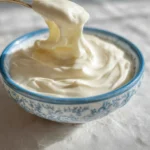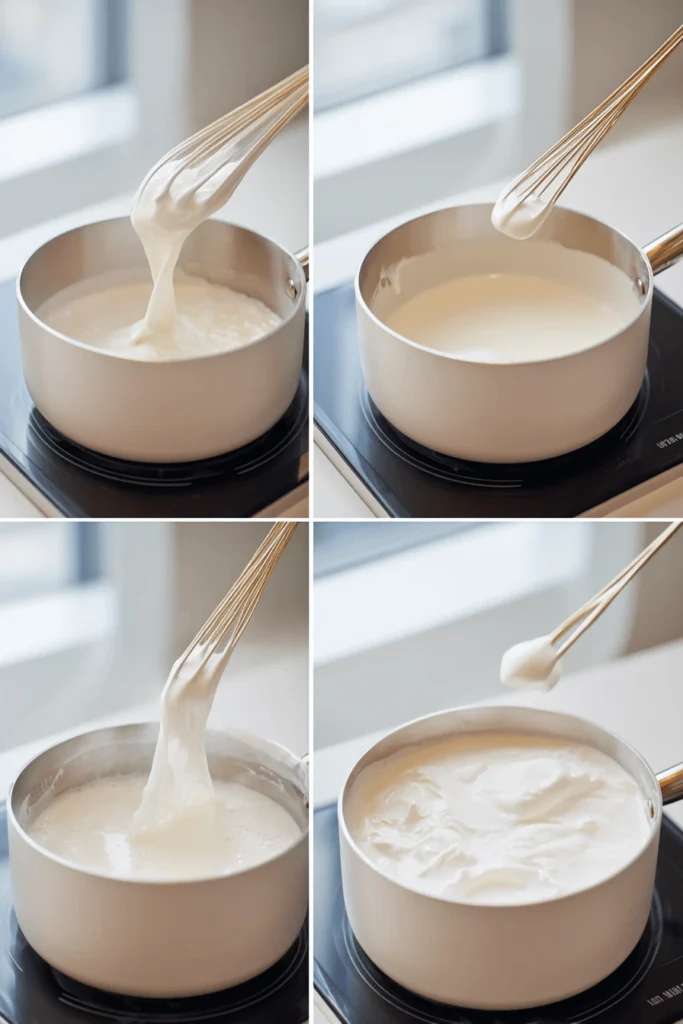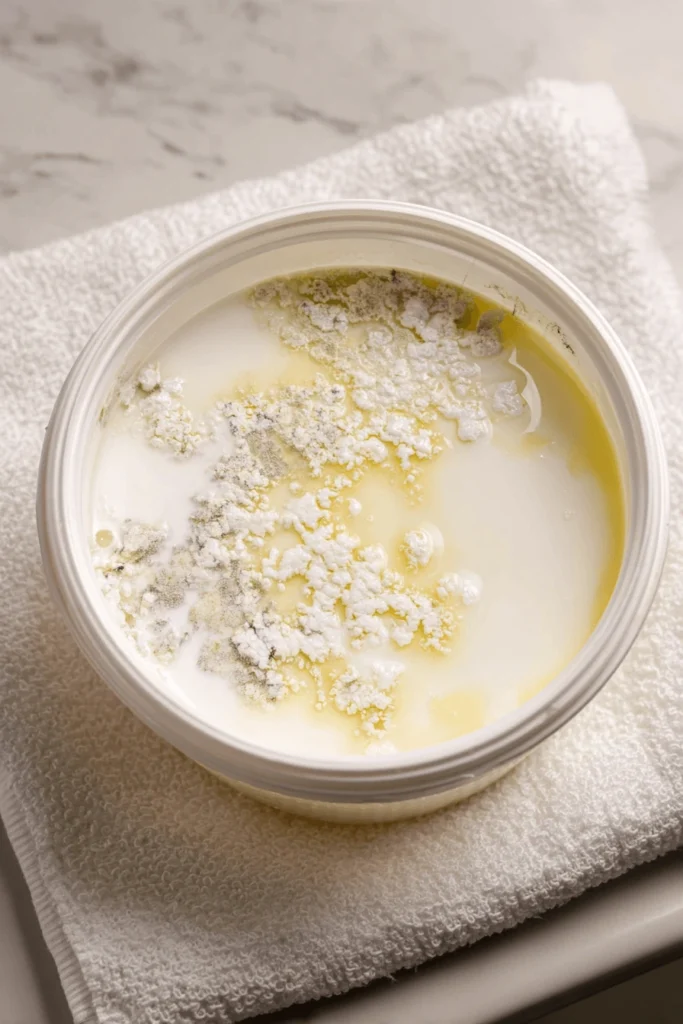Imagine this: You’re in your kitchen, goggles on (just for fun), stirring together plain thick yogurt, a splash of milk, perhaps a bit of starch or a secret culture—you knead it, you stretch it, and you pull it like cheesy taffy. That, dear reader, is Stretchy Yogurt. It’s a playful spin on traditional yogurt, combining tang, creaminess, and that satisfying elastic pull that makes people double-tap their food posts. In this article, we’ll dive deep into Stretchy Yogurt — what makes it stretchy, how it relates to strained yogurts like Greek yogurt or labneh, whether it’s healthy, how to tell if it’s gone bad, and more.
Print
Stretchy Yogurt
- Total Time: 10–12 hours
Ingredients
4 cups whole milk (or plant-based milk for vegan version)
2 tablespoons plain Greek yogurt with live cultures (starter)
1–2 teaspoons tapioca starch (optional, for extra stretch)
Sweet or savory flavorings (optional): honey, fruit purée, herbs, garlic, lemon
Instructions
Heat the Milk: Pour milk into a heavy-bottomed saucepan and heat to 185°F (85°C), stirring occasionally.
Cool the Milk: Remove from heat and cool to 110°F (43°C).
Add the Starter: Whisk in Greek yogurt or powdered starter until evenly combined.
Incubate: Transfer mixture into jars and maintain at 110°F (43°C) for 6–8 hours. Yogurt should thicken.
Optional Starch Addition: Dissolve tapioca starch in a small amount of cool water and mix into the yogurt to enhance elasticity.
Chill: Refrigerate for at least 4 hours to allow the protein-starch network to strengthen.
Serve: Pull and stretch the yogurt with a spoon or hands for the classic stretchy texture. Add sweet toppings like honey and fruit or savory mix-ins like garlic and herbs.
Notes
Use sanitized utensils and containers to prevent contamination.
Homemade Stretchy Yogurt lasts 5–7 days in the refrigerator.
Adjust incubation and starch levels to get your preferred stretch and taste.
- Prep Time: 15 minutes
- Cook Time: Cook/Incubation Time: 6–8 hours | Chill Time: 4 hours
Nutrition
- Serving Size: 4–6
Table of Contents
What Is Stretchy Yogurt?
H2: Defining Stretchy Yogurt — Texture and Ingredients
Stretchy Yogurt isn’t your everyday spoonful of plain yogurt. Instead of that familiar creamy scoop, this variation has a unique pull and elasticity that almost feels like melted cheese. So, what’s going on here? The stretch comes from a mix of natural proteins in milk, the type of bacterial cultures used, and sometimes the addition of starches or thickeners. Unlike regular yogurt, which is smooth and silky, Stretchy Yogurt can be tugged and twisted, offering a playful texture that surprises first-time tasters.
The basic ingredients are straightforward: whole milk or strained yogurt, a starter culture (often similar to the ones used in Greek yogurt or labneh), and sometimes a helping hand from starches like tapioca or potato starch. These starches bind with the milk proteins, creating that signature stretch you can see and feel. Depending on the recipe, some people use plain Greek yogurt as the base, others start from scratch with fresh milk, but the end goal is the same—a tangy yogurt that you can pull like mozzarella.
H2: How Stretchy Yogurt Differs From Regular & Strained Yogurt
At first glance, you might think Stretchy Yogurt is just another name for Greek yogurt or labneh, but the texture tells a different story. Regular yogurt keeps much of its whey intact, making it softer and sometimes runnier. Strained yogurt, on the other hand, has that whey removed, resulting in a thicker, creamier consistency. Neither naturally develops the same elastic quality.
Stretchy Yogurt sits in its own category. It’s not just about removing whey; it’s about encouraging proteins and starches to form a web-like structure that holds together when pulled. If Greek yogurt is the dense, creamy cousin, then Stretchy Yogurt is the playful, bendy one at the family reunion. You’ll find it works beautifully in spreads, dips, or even as a topping when you want a fun twist on traditional yogurt dishes.
How To Make Stretchy Yogurt At Home
Equipment, Milk Choice, and Starter Cultures
Making Stretchy Yogurt doesn’t require a high-tech kitchen. With just a few tools and the right ingredients, you can achieve that elastic, pull-apart texture in your own home.
- Equipment you’ll need: a heavy-bottomed saucepan, a thermometer, a whisk, a fine strainer, and clean glass jars with lids. If you want extra control, a yogurt maker or Instant Pot with a yogurt setting works perfectly.
- Best milk options: Whole cow’s milk delivers the richest and most consistent stretch because it contains higher levels of casein and fat. Goat’s milk and sheep’s milk can also work, though their proteins behave slightly differently. Non-dairy milk, such as coconut or soy, requires more starch to mimic the same structure.
- Starter cultures: You can use a spoonful of plain Greek yogurt with live cultures or purchase a freeze-dried starter. Cultures rich in Lactobacillus bulgaricus and Streptococcus thermophilus are ideal, as they provide the tang and help create the structure that supports stretch.
Step-by-Step Recipe For Stretchy Yogurt
Here’s a simple method to guide you through the process:
Heating, Cooling, and Inoculation

- Heat the milk — Pour 4 cups of whole milk into your saucepan and slowly heat it to about 185°F (85°C). This denatures the whey proteins so they’ll bind better.
- Cool it down — Remove the saucepan from the heat and let the milk cool to around 110°F (43°C). This is the sweet spot for bacteria activity.
- Add the starter — Whisk in 2 tablespoons of plain yogurt with live cultures (or your powdered starter). Mix thoroughly so the bacteria spread evenly.
Incubation and Stretch Development
- Incubate — Transfer the inoculated milk into jars, cover them, and place them in a warm spot or yogurt maker at 110°F (43°C). Let them sit undisturbed for 6–8 hours, or until the yogurt has thickened and set.
- Add starch (optional but recommended) — If you want more reliable stretch, dissolve 1–2 teaspoons of tapioca starch in a bit of cool water, then stir it into the yogurt after incubation. Mix well.
- Chill and rest — Refrigerate the yogurt for at least 4 hours. As it cools, the protein-starch network strengthens.
The Stretch Test
After chilling, take a spoonful and slowly lift it. If the yogurt pulls and stretches like soft taffy, you’ve nailed it. Too runny? Try adding a bit more starch next time or incubating slightly longer. Too gummy? Cut back on the starch.
With a little practice, you’ll find the perfect balance that turns everyday yogurt into the delightful, elastic experience we call Stretchy Yogurt.
For a refreshing twist, try pairing your stretchy yogurt with vibrant fruits—our Tropical Smoothie Recipes are perfect inspiration.
Variations & Twists of Stretchy Yogurt
HCultural & Regional Styles
Across the globe, yogurt has been transformed into countless delicious variations. While Stretchy Yogurt is still a playful newcomer for many, it shares similarities with long-standing traditions.
Labneh, Greek Yogurt, and Skyr
Labneh, a Middle Eastern staple, is made by straining yogurt until it becomes thick enough to spread like cream cheese. While it doesn’t stretch in the same way, its dense texture makes it an excellent base for savory dips or sandwich spreads. Greek yogurt, popular in the United States, is strained but creamier and lighter than labneh, while Icelandic skyr is technically a cheese but resembles a super-thick yogurt with high protein content. These cousins to Stretchy Yogurt highlight the importance of whey removal and protein concentration in achieving unique textures.
Other Elastic or Thickened Dairy Traditions
Certain regional cheeses, like mozzarella or Armenian string cheese, share the same stretchy characteristic caused by protein realignment during heating. While they aren’t yogurts, their preparation methods reveal why elasticity is possible in dairy. Yogurt-based desserts such as “mishti doi” in India or yogurt puddings in Turkey don’t stretch but show how versatile cultured milk can be when paired with starch or heat treatments. Together, they point to how Stretchy Yogurt is both a novelty and part of a much larger family of dairy innovations.
Flavorings, Serving Styles & Pairings
Once you’ve got the base recipe for Stretchy Yogurt, the real fun begins. Flavoring and pairing can turn a plain batch into a sweet treat, a savory snack, or even a show-stopping dip at your next gathering.
Sweet vs. Savory Stretch Yogurt
For sweet versions, drizzle honey, maple syrup, or fruit purées over the stretchy base. Fresh berries, chopped mango, or roasted peaches add bursts of flavor and color. Sprinkle granola or crushed nuts for crunch.
For savory takes, think of it as a flexible dip. Mix in garlic, lemon juice, and herbs like dill or parsley. You can also blend in roasted red peppers, sun-dried tomatoes, or olive tapenade for a Mediterranean flair. Pair with warm flatbreads, pita chips, or crunchy vegetables.
Creative Serving Ideas

- As a spread — Use Stretchy Yogurt instead of cream cheese on bagels or wraps.
- In bowls — Layer with grains, roasted vegetables, and herbs for a filling meal.
- As a dip — Place it in the center of a platter surrounded by crudités.
- For kids — Swirl it with fruit jam for a fun, colorful snack that keeps them reaching for more.
The playful texture isn’t just for novelty. The ability to stretch changes the eating experience, making Stretchy Yogurt a talking point at any table.
If you love creamy textures like in Stretchy Yogurt, you might also enjoy experimenting with rich and moist desserts such as our Mini Tres Leches Cake Recipes
Health & Nutrition Aspects of Stretchy Yogurt
Nutritional Benefits
Yogurt is often praised as one of the healthiest fermented foods, and Stretchy Yogurt is no exception. Thanks to its base of cultured milk, it delivers a balance of protein, probiotics, vitamins, and minerals.
Protein, Probiotics, and Calcium
One of the standout benefits of Stretchy Yogurt is its protein content. Whole milk yogurt contains casein, which helps with muscle repair and keeps you feeling fuller longer. When strained or thickened, that protein concentration rises even more.
Probiotics are another highlight. The live cultures in Stretchy Yogurt support gut health, improve digestion, and may even boost immunity. Calcium, essential for strong bones and teeth, is abundant here, along with vitamin B12 and riboflavin. For many people, adding stretchy or strained yogurt to their diet can be an easy way to cover nutritional bases without extra supplements.
Fat Content and Energy Value
Whole milk versions of Stretchy Yogurt are naturally higher in fat, which provides energy and enhances the creamy mouthfeel. While some may worry about fat, research shows that dairy fats in moderation can be part of a balanced diet. Those seeking lighter versions can use low-fat or reduced-fat milk, but the texture may lose some of its signature elasticity.
Possible Downsides & Sensitivities
As with most dairy products, Stretchy Yogurt may not be suitable for everyone. Understanding its limitations helps you enjoy it safely.
Lactose Intolerance and Sensitivities
Although fermentation reduces lactose content, Stretchy Yogurt still contains some lactose. People with mild intolerance may tolerate small amounts, especially when paired with other foods, but those with severe lactose sensitivity should explore lactose-free milk or non-dairy alternatives.
When Stretch Isn’t a Good Sign
Not all stretchiness is a badge of success. In some cases, slimy or overly stringy yogurt can signal unwanted bacterial activity. Contamination or improper incubation can create textures that look stretchy but aren’t safe to eat. If your batch smells off, tastes strange, or has visible mold, it’s best to toss it. While Stretchy Yogurt is fun and innovative, safety always comes first.
Boost nutrition by mixing in superfoods—just like we do in Chia Seeds in Fruit Smoothies, adding seeds can enhance your yogurt’s texture and health benefits.
Stretchy Yogurt vs. Alternative Fermented Dairy & Non-Dairy Products
Stretchy Yogurt Compared With Kefir, Regular Yogurt & Sour Cream
When it comes to fermented foods, Stretchy Yogurt occupies a unique niche. Unlike kefir, which is drinkable and thinner, Stretchy Yogurt is thicker, elastic, and ideal for dipping or spreading.
Probiotic Counts, Texture, and Culinary Uses
Kefir contains a diverse array of probiotics, often more than yogurt, making it excellent for gut health, but it doesn’t have the same creamy pull. Regular yogurt is versatile and mildly tangy but usually lacks the elasticity that makes Stretchy Yogurt playful and fun. Sour cream, on the other hand, is richer and tangier but primarily used as a condiment, not a snack with a stretchable texture.
In cooking, Stretchy Yogurt can act as a spread, a base for desserts, or even a component in sauces where its elastic nature adds a surprising twist. This versatility makes it stand out compared to traditional alternatives.
Non-Dairy Stretchy Yogurt Options
With rising interest in plant-based diets, non-dairy versions of stretchy yogurt are increasingly popular. Using coconut, almond, or soy milk as a base, these versions aim to mimic the texture and elasticity of dairy Stretchy Yogurt.
Plant-Based Milks and Stretch Techniques
Since plant proteins behave differently, achieving stretch requires extra attention. Tapioca starch, agar, or guar gum are often used to bind the proteins and liquids, replicating the stretchy texture. Coconut milk offers creaminess, almond milk gives a mild flavor, and soy milk provides higher protein, which helps support elasticity.
Balancing Taste and Nutrition
Non-dairy Stretchy Yogurt can still provide probiotics if cultured with live starter cultures. While calcium and vitamin B12 levels may be lower than in dairy versions, fortification and pairing with nuts, seeds, or fortified plant milks can bridge the gap. Flavorings such as vanilla, fruit purées, or spices help make non-dairy versions just as enjoyable, ensuring that everyone can experience the stretchy magic regardless of dietary preference.
Since Stretchy Yogurt is inspired by Greek-style yogurts, check out our Easy Greek Recipes for more Mediterranean flavor ideas.
Common Problems & How To Fix Them
Texture Issues — Stretch Too Much, Too Little, Slimy, Grainy
Even seasoned yogurt makers can face unexpected results when making Stretchy Yogurt. Understanding why these issues occur helps ensure consistent, delicious outcomes.
Why Yogurt Becomes Slimy or Stringy
Sometimes, what looks like a stretchy miracle is actually a slimy batch caused by wild yeasts or improper bacterial growth. Over-incubation, uneven temperatures, or contaminated equipment can trigger unwanted microbial activity, resulting in an unpleasant texture. Always sanitize jars, utensils, and your hands before handling yogurt to avoid contamination.
Adjusting Variables for Optimal Stretch
If your yogurt isn’t stretching enough, consider:
- Slightly increasing the incubation time (but not too long).
- Using a higher-protein milk or adding a small amount of starch.
- Ensuring the starter culture is fresh and active.
Too gummy or overly stiff? Reduce starch or slightly shorten incubation time. The key is balancing proteins, bacteria, and heat to achieve that perfect pull.
Taste, Tang & Consistency Fixes
When Yogurt Is Too Sour or Too Mild
The tang in Stretchy Yogurt comes from lactic acid produced by the cultures. Too sour? Reduce incubation time or use a milder starter culture. Too bland? Allow fermentation a bit longer or experiment with a mix of active cultures to boost flavor naturally.
When Yogurt Is Runny
Runny yogurt can result from low protein content, insufficient incubation, or whey not being properly integrated. Straining the yogurt through a fine mesh or adding a small amount of starch can help thicken it without sacrificing elasticity.
With these adjustments, your Stretchy Yogurt will reliably achieve the ideal balance of taste and texture every time, whether you’re making it for a fun snack, a party dip, or a gourmet breakfast bowl.
Food Safety — When Stretchy Yogurt Is Spoiled Or Dangerous
How To Tell If Yogurt Is Spoiled
Even the most carefully made Stretchy Yogurt can go bad if it’s not stored properly. Knowing the signs of spoilage is essential to protect your health.
Smell, Color, Mold, and Separation
Spoiled yogurt often develops a sour, off-putting odor beyond its normal tang. Look for:
- Mold growth — any fuzzy green, blue, or black spots mean it’s unsafe.
- Discoloration — yellowish or gray tints indicate spoilage.
- Whey separation — while some liquid on top is normal, excessive separation with off odors is a red flag.

If any of these signs appear, discard the batch immediately. Even a small taste test is risky.
Shelf-Life — Homemade vs. Commercial
Homemade Stretchy Yogurt typically lasts 5–7 days in the refrigerator when stored in clean, airtight containers. Commercial products may last longer due to pasteurization, preservatives, or vacuum-sealed packaging. Always check expiration dates and keep yogurt cold to maintain safety and texture.
Risks — Can Bad Yogurt Cause Food Poisoning?
Harmful Bacteria and Toxins
Improperly handled yogurt can harbor bacteria like Salmonella, E. coli, or Listeria, which may lead to foodborne illness. Overgrown wild yeasts or molds can also produce toxins that are unsafe to consume.
Safe Storage and Handling Tips
- Refrigerate immediately after preparation.
- Use clean utensils to serve.
- Avoid leaving yogurt at room temperature for more than 2 hours.
- Label homemade batches with the date to track freshness.
By following these guidelines, you can safely enjoy Stretchy Yogurt while preventing contamination or spoilage. Safe practices ensure that the playful, elastic texture is paired with healthy, delicious eating.
Frequently Asked Questions
Why is my yogurt stretchy?
Stretchy Yogurt achieves its unique texture through a combination of protein concentration, bacterial cultures, and sometimes added starches or thickeners. Proteins like casein form a network during fermentation that, when properly balanced, allows the yogurt to stretch instead of just being creamy. Temperature, incubation time, and the type of milk used also influence the elasticity.
What is strained yogurt called?
Strained yogurt is commonly known as Greek yogurt or labneh. Straining removes excess whey, resulting in a thicker consistency. While these yogurts are dense and creamy, they don’t always have the elastic quality of Stretchy Yogurt unless extra steps like adding starch or manipulating the protein structure are taken.
Is kefir healthier than yogurt?
Kefir is a fermented milk drink that often contains more probiotic strains than yogurt. While it’s excellent for gut health, it’s drinkable rather than spreadable, and it lacks the playful elasticity of Stretchy Yogurt. Both kefir and stretchy yogurt offer health benefits, so the choice depends on dietary goals and culinary preference.
How can I tell if yogurt is spoiled?
Spoiled yogurt may have an off odor, discoloration, visible mold, or excessive liquid separation. If it smells sour beyond the typical tang, shows green or blue mold, or has a grayish tint, it’s unsafe to eat. Homemade Stretchy Yogurt usually lasts 5–7 days in the fridge, so always store it properly.
Can bad yogurt cause food poisoning?
Yes. Improperly handled yogurt can harbor harmful bacteria like Salmonella, E. coli, or Listeria. These can cause foodborne illnesses. Always refrigerate yogurt, use clean utensils, and avoid leaving it at room temperature for extended periods to reduce risk.
Find more delicious recipes on DifferentyRecipes Pinterest, and stay inspired with the newest tips and ideas by following DifferentyRecipes on Facebook.
Conclusion
Stretchy Yogurt is more than just a fun twist on a classic favorite—it’s a science, an art, and a delicious culinary adventure all in one. From understanding how proteins and cultures create that perfect elasticity, to experimenting with flavors and variations, this yogurt proves that creativity in the kitchen can be both playful and healthy. Whether you enjoy it sweet, savory, dairy, or plant-based, mastering Stretchy Yogurt offers endless possibilities for meals, snacks, and entertaining.
